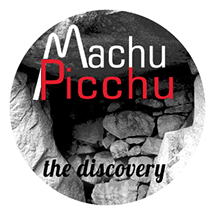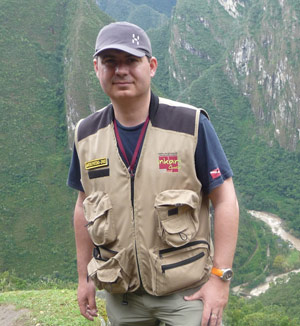
The French engineer David Crespy, at the origin of this incredible story.
In February, 2010, David Crespy measures ruins and small passages of the antique city. At the heart of the ciudadela, he notices the presence of a strange “door”, situated at the foot of one of the main buildings giving onto a small passage which borrow almost never the tourists, or even the archaeologists. For him, it makes hardly doubt that it is in fact about an entrance sealed by the Incas. For him, there is no doubt: it is about an entrance leading somewhere. He warns immediately the archaeologists and the persons in charge of Machu Picchu. On-the-spot conduits, the latter seem interested and promise to David Crespy to realize more ample investigations on the place. Furthermore, they will hold him informed. But months pass and David Crespy, in spite of numerous relaunchings, receives no more piece of news of Peru and his possible discovery. In August, 2011, it falls by chance on an article of the French review Le Figaro Magazine evoking the searches in Peru of Thierry Jamin. He gets in touch immediately with him.
Informed about the affair, Thierry Jamin, who was interested in numerous sites in funeral context in the North of Cusco, confirms David Crespy’s remarks. Accompanied with archaeologists, he goes to diverse occasions to Machu Picchu, between September and November, 2011, to the indicated place. His preliminary conclusions are categorical: it is well about an entrance, blocked by the Incas in an indefinite time. This one is strangely similar to that of a funeral site, such as Thierry Jamin and his companions often met it in the valleys of Lacco-Yavero and Chunchusmayo.
A secret door?
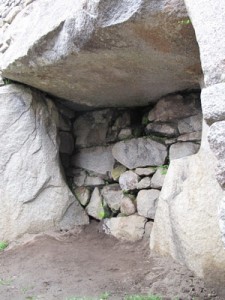
The famous entrance discovered by David Crespy in 2010. What secrets does it contain?
The general context of this “door”, fitted out in the center of one of the main buildings of the city, the “Temple of Three Doors“, dominating the whole urban sector, persuades Thierry Jamin that it is undoubtedly about a funeral site of first importance.
Thanks to David Crespy, the French researcher thinks of having located the entrance of an important grave (maybe royal) in the heart of the city. The “Plan Maestro” of Machu Picchu (It is about a reference document, realized by the Peruvian authorities for the management of the inca citadel) consider the building as a Kallanka (sic), or a place of rest, of inca time. But it does not seem to correspond to the general configuration of the site, located just a step from the main entrance of the inca city, directly above the “torreón” -a miniature reproduction of the Qoricancha, the Temple of the Sun of Cusco-, the supposed “Royal Grave” (So identified by Hiram Bingham) and on the path towards the religious sector.
The tradition and certain old chronicles, as that Juan de Betanzos, report that Machu Picchu belonged to the panaka (lineage) of emperor Pachacútec, the Inca who transformed the small Andean State into the most powerful empire of the American continent. The tradition also brings back that would have been interred in the city of Patallacta, the original name of Machu Picchu. It is very possible that this funeral chamber relates to this sovereign of the XVth century. It would be a big event for the history of Peru and pre-Colombian America. We found, indeed, until now, no mummy of inca emperor. It would be an historical previous !
On March 22nd, 2012, by his Resolución Directoral Nacional, N° 144 – 2012 – DGPC-VMPCIC / MC, the Peruvian Ministry of Culture gives its green light to Thierry Jamin’s team to realize a series of electromagnetic echos intended to confirm, or not, the presence of a funeral chamber, in the basement of the building N° 02, Sector 02, Sub-sector E, Unity 03 of the lost city.
The measurements reveal an underground cavity
Realized from 09 till 17 April of the same year, these echos are going to confirm the presence of one or several cavities under the building in question. The research team succeeds in confirming the existence of two entrances, situated behind the famous door, thanks to the use of a georadar Golden King DPRP. The researchers also succeed in obtaining the image in 3D of a staircase leading towards a main room: a funeral chamber?
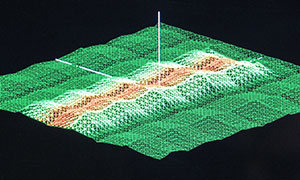
Representation in 3D of the staircases leading towards a main room.
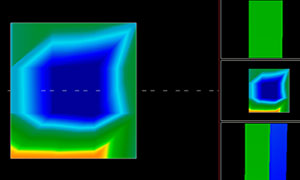
The main room, maybe a crypt, discovered on April 17th, 2012 by echos electromagnetic.
A few days later, new echos realized by a Rover CII New Edition and a CaveFinder, the technical specificities of which are exactly the detection of subterranean cavities, confirm the presence of a staircase, numerous cavities, among which a vast quadrangular room, about three meters aside, managed north-south east-west.
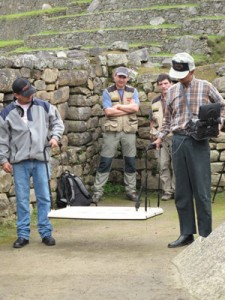
Mario Escobar (to the left) and Ricardo Tamaki (to the right) realize electromagnetic echos with a “super sensor” under the look of David Crespy and Daniel Merino (in the center).
Georadars is also going to detect the existence of metals in great quantities. The located deposits are generally associated to the spotted cavities. The use of a Molecular Discriminator of Frequencies, is going to highlight as for him the presence of golden and silver objects.
Finally, the use of an endoscopic camera, introduced into the elevations hidting the entrance, confirms the hypothesis according to which stony blocks and engraved them arranged in the entrance of the building had only the function to block a passage and not that to support the internal structures of the building. Wide empty spaces let glimpse the existence of a mysterious corridor…
It seems that Thierry Jamin and its group do not make a mistake. The echos are formal and the diagnostics realized by the technicians of the various companies having realized the echos, are without ambiguity. All the cavities discovered by the Instituto Inkari – Cusco seems to correspond to a classic funeral boss of prehispanic time. Moreover, the entrance located by David Crespy managed eastward is itself, as most of the prehispanic funeral sites.
In all probability, it is well about a door, closed by the Incas, to hide something of apparently very important. Here hides maybe the main archaeological treasure of Machu Picchu. The hypothesis defended by Thierry Jamin moves forward that he could involve a Mausoleum, the one that emperor Pachacútec was built in the XVth century to deposit his grave and that of his lineage there.
